Unit 42: Planning for Growth: Nisa Retail Business Strategies Report
VerifiedAdded on 2021/01/01
|17
|4472
|311
Report
AI Summary
This report provides a comprehensive analysis of growth strategies for Nisa, a retail business. It begins with an introduction to the importance of planning for growth in the retail sector, followed by a PESTLE analysis to identify external factors impacting the industry. The report then explores growth opportunities using Ansoff's Growth Matrix and Porter's Generic Strategies, focusing on market penetration and product development. Furthermore, it details various funding sources available to businesses, including bank loans, crowdfunding, peer-to-peer lending, and angel investors, outlining their advantages and disadvantages. A business plan is discussed, highlighting strategies for growth and introducing new products. Finally, the report covers succession and exit options for small businesses, ensuring a well-rounded understanding of growth management in the retail sector.

UNIT 42 PLANNING FOR
GROWTH
GROWTH
Paraphrase This Document
Need a fresh take? Get an instant paraphrase of this document with our AI Paraphraser
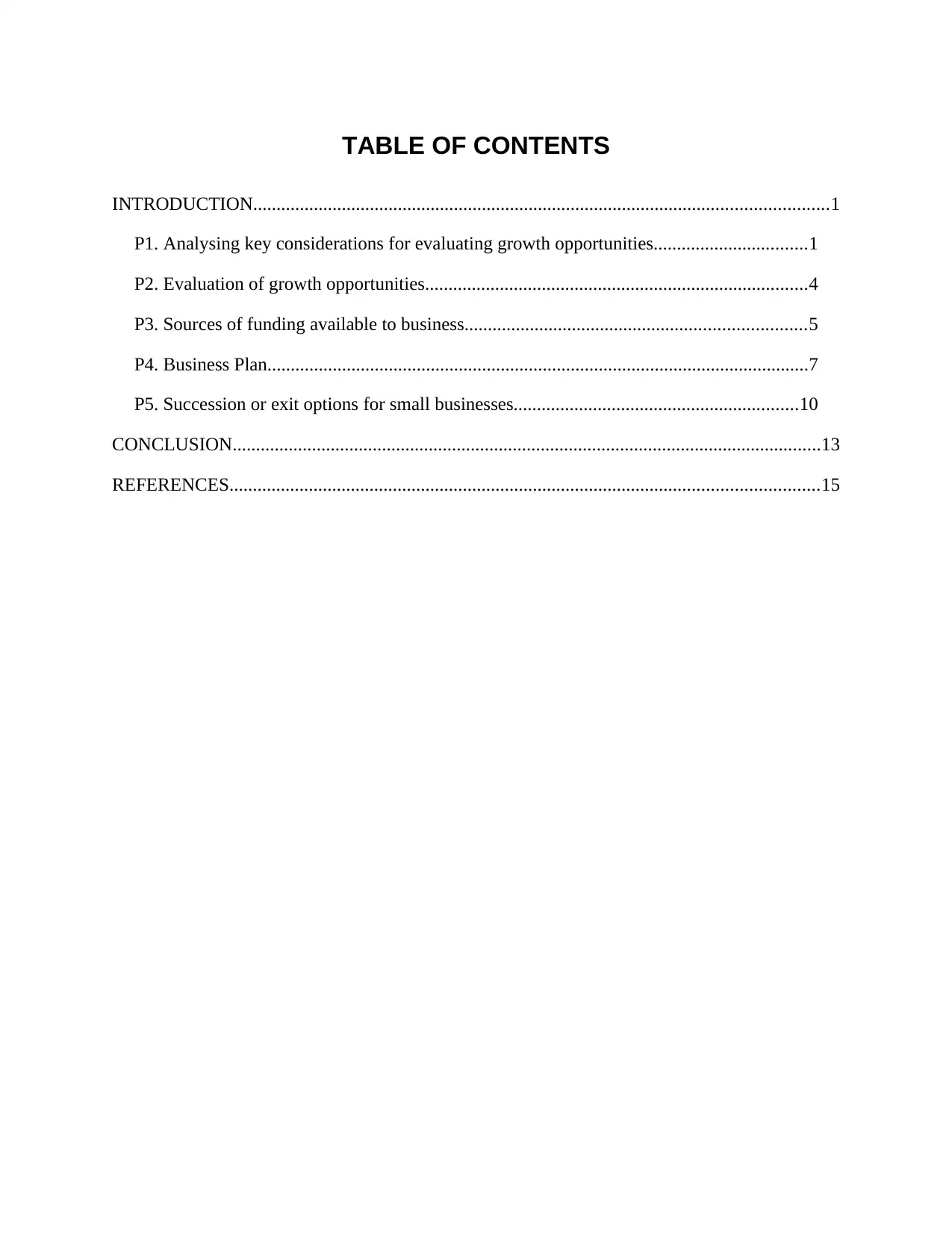
TABLE OF CONTENTS
INTRODUCTION...........................................................................................................................1
P1. Analysing key considerations for evaluating growth opportunities.................................1
P2. Evaluation of growth opportunities..................................................................................4
P3. Sources of funding available to business.........................................................................5
P4. Business Plan....................................................................................................................7
P5. Succession or exit options for small businesses.............................................................10
CONCLUSION..............................................................................................................................13
REFERENCES..............................................................................................................................15
INTRODUCTION...........................................................................................................................1
P1. Analysing key considerations for evaluating growth opportunities.................................1
P2. Evaluation of growth opportunities..................................................................................4
P3. Sources of funding available to business.........................................................................5
P4. Business Plan....................................................................................................................7
P5. Succession or exit options for small businesses.............................................................10
CONCLUSION..............................................................................................................................13
REFERENCES..............................................................................................................................15
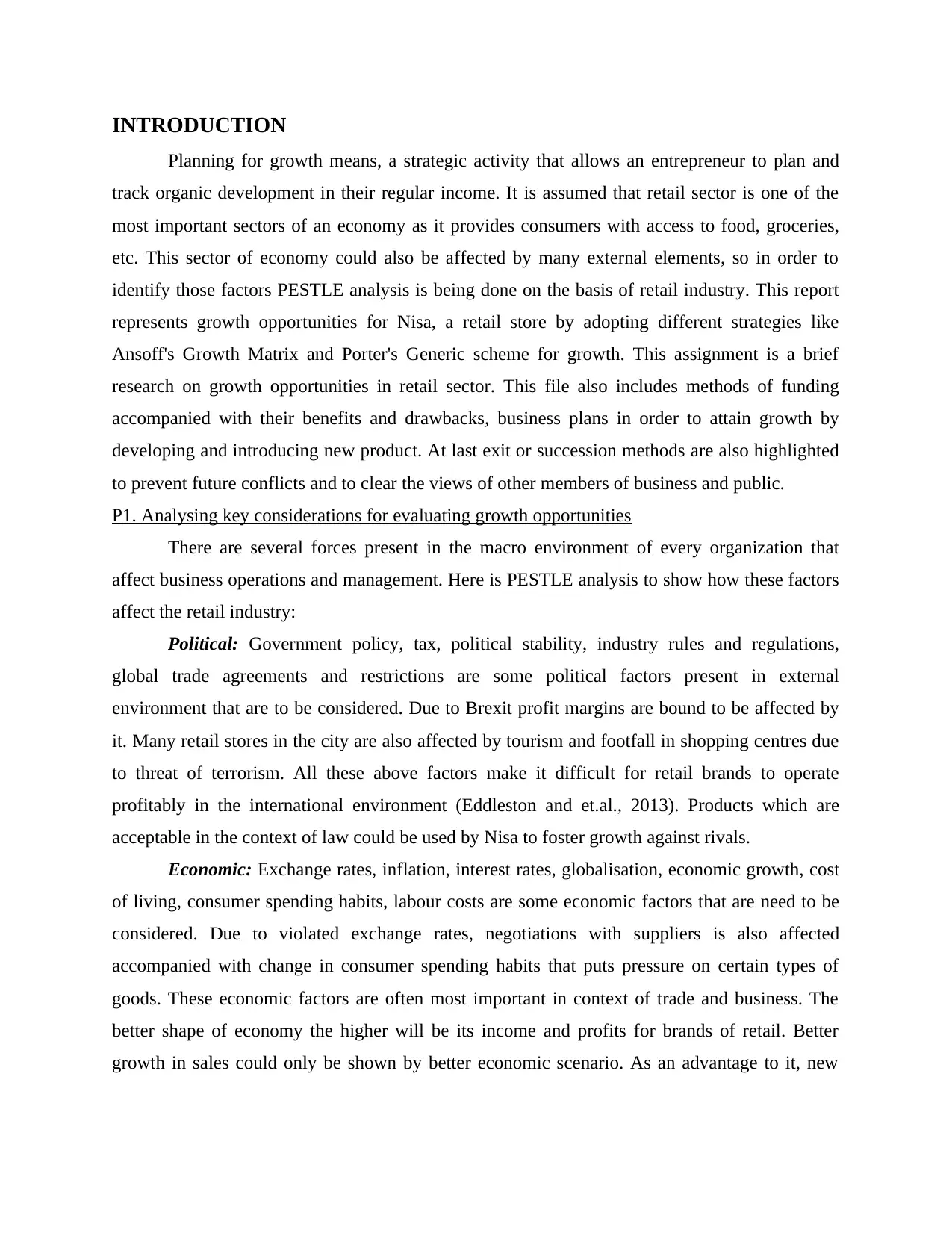
INTRODUCTION
Planning for growth means, a strategic activity that allows an entrepreneur to plan and
track organic development in their regular income. It is assumed that retail sector is one of the
most important sectors of an economy as it provides consumers with access to food, groceries,
etc. This sector of economy could also be affected by many external elements, so in order to
identify those factors PESTLE analysis is being done on the basis of retail industry. This report
represents growth opportunities for Nisa, a retail store by adopting different strategies like
Ansoff's Growth Matrix and Porter's Generic scheme for growth. This assignment is a brief
research on growth opportunities in retail sector. This file also includes methods of funding
accompanied with their benefits and drawbacks, business plans in order to attain growth by
developing and introducing new product. At last exit or succession methods are also highlighted
to prevent future conflicts and to clear the views of other members of business and public.
P1. Analysing key considerations for evaluating growth opportunities
There are several forces present in the macro environment of every organization that
affect business operations and management. Here is PESTLE analysis to show how these factors
affect the retail industry:
Political: Government policy, tax, political stability, industry rules and regulations,
global trade agreements and restrictions are some political factors present in external
environment that are to be considered. Due to Brexit profit margins are bound to be affected by
it. Many retail stores in the city are also affected by tourism and footfall in shopping centres due
to threat of terrorism. All these above factors make it difficult for retail brands to operate
profitably in the international environment (Eddleston and et.al., 2013). Products which are
acceptable in the context of law could be used by Nisa to foster growth against rivals.
Economic: Exchange rates, inflation, interest rates, globalisation, economic growth, cost
of living, consumer spending habits, labour costs are some economic factors that are need to be
considered. Due to violated exchange rates, negotiations with suppliers is also affected
accompanied with change in consumer spending habits that puts pressure on certain types of
goods. These economic factors are often most important in context of trade and business. The
better shape of economy the higher will be its income and profits for brands of retail. Better
growth in sales could only be shown by better economic scenario. As an advantage to it, new
Planning for growth means, a strategic activity that allows an entrepreneur to plan and
track organic development in their regular income. It is assumed that retail sector is one of the
most important sectors of an economy as it provides consumers with access to food, groceries,
etc. This sector of economy could also be affected by many external elements, so in order to
identify those factors PESTLE analysis is being done on the basis of retail industry. This report
represents growth opportunities for Nisa, a retail store by adopting different strategies like
Ansoff's Growth Matrix and Porter's Generic scheme for growth. This assignment is a brief
research on growth opportunities in retail sector. This file also includes methods of funding
accompanied with their benefits and drawbacks, business plans in order to attain growth by
developing and introducing new product. At last exit or succession methods are also highlighted
to prevent future conflicts and to clear the views of other members of business and public.
P1. Analysing key considerations for evaluating growth opportunities
There are several forces present in the macro environment of every organization that
affect business operations and management. Here is PESTLE analysis to show how these factors
affect the retail industry:
Political: Government policy, tax, political stability, industry rules and regulations,
global trade agreements and restrictions are some political factors present in external
environment that are to be considered. Due to Brexit profit margins are bound to be affected by
it. Many retail stores in the city are also affected by tourism and footfall in shopping centres due
to threat of terrorism. All these above factors make it difficult for retail brands to operate
profitably in the international environment (Eddleston and et.al., 2013). Products which are
acceptable in the context of law could be used by Nisa to foster growth against rivals.
Economic: Exchange rates, inflation, interest rates, globalisation, economic growth, cost
of living, consumer spending habits, labour costs are some economic factors that are need to be
considered. Due to violated exchange rates, negotiations with suppliers is also affected
accompanied with change in consumer spending habits that puts pressure on certain types of
goods. These economic factors are often most important in context of trade and business. The
better shape of economy the higher will be its income and profits for brands of retail. Better
growth in sales could only be shown by better economic scenario. As an advantage to it, new
⊘ This is a preview!⊘
Do you want full access?
Subscribe today to unlock all pages.

Trusted by 1+ million students worldwide
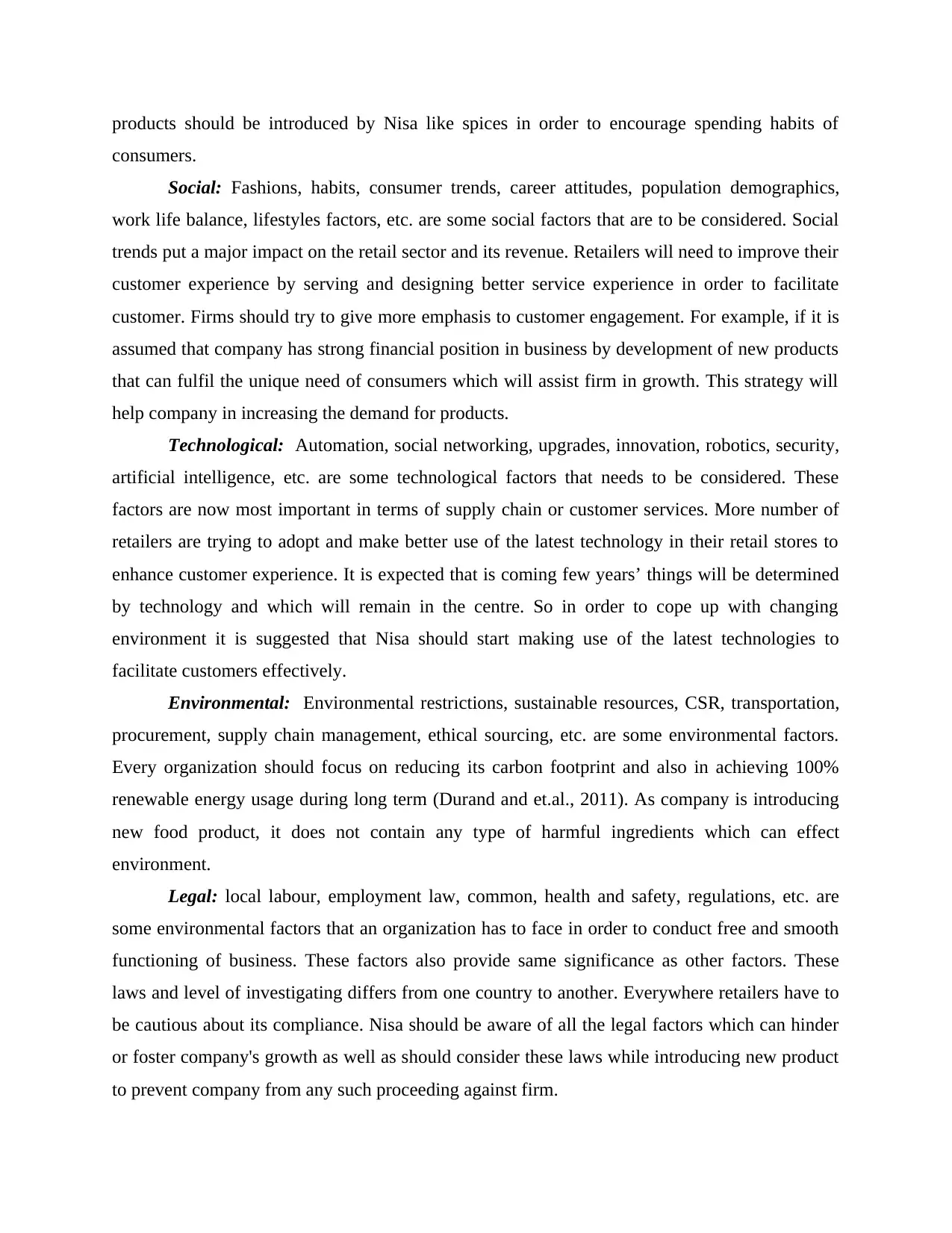
products should be introduced by Nisa like spices in order to encourage spending habits of
consumers.
Social: Fashions, habits, consumer trends, career attitudes, population demographics,
work life balance, lifestyles factors, etc. are some social factors that are to be considered. Social
trends put a major impact on the retail sector and its revenue. Retailers will need to improve their
customer experience by serving and designing better service experience in order to facilitate
customer. Firms should try to give more emphasis to customer engagement. For example, if it is
assumed that company has strong financial position in business by development of new products
that can fulfil the unique need of consumers which will assist firm in growth. This strategy will
help company in increasing the demand for products.
Technological: Automation, social networking, upgrades, innovation, robotics, security,
artificial intelligence, etc. are some technological factors that needs to be considered. These
factors are now most important in terms of supply chain or customer services. More number of
retailers are trying to adopt and make better use of the latest technology in their retail stores to
enhance customer experience. It is expected that is coming few years’ things will be determined
by technology and which will remain in the centre. So in order to cope up with changing
environment it is suggested that Nisa should start making use of the latest technologies to
facilitate customers effectively.
Environmental: Environmental restrictions, sustainable resources, CSR, transportation,
procurement, supply chain management, ethical sourcing, etc. are some environmental factors.
Every organization should focus on reducing its carbon footprint and also in achieving 100%
renewable energy usage during long term (Durand and et.al., 2011). As company is introducing
new food product, it does not contain any type of harmful ingredients which can effect
environment.
Legal: local labour, employment law, common, health and safety, regulations, etc. are
some environmental factors that an organization has to face in order to conduct free and smooth
functioning of business. These factors also provide same significance as other factors. These
laws and level of investigating differs from one country to another. Everywhere retailers have to
be cautious about its compliance. Nisa should be aware of all the legal factors which can hinder
or foster company's growth as well as should consider these laws while introducing new product
to prevent company from any such proceeding against firm.
consumers.
Social: Fashions, habits, consumer trends, career attitudes, population demographics,
work life balance, lifestyles factors, etc. are some social factors that are to be considered. Social
trends put a major impact on the retail sector and its revenue. Retailers will need to improve their
customer experience by serving and designing better service experience in order to facilitate
customer. Firms should try to give more emphasis to customer engagement. For example, if it is
assumed that company has strong financial position in business by development of new products
that can fulfil the unique need of consumers which will assist firm in growth. This strategy will
help company in increasing the demand for products.
Technological: Automation, social networking, upgrades, innovation, robotics, security,
artificial intelligence, etc. are some technological factors that needs to be considered. These
factors are now most important in terms of supply chain or customer services. More number of
retailers are trying to adopt and make better use of the latest technology in their retail stores to
enhance customer experience. It is expected that is coming few years’ things will be determined
by technology and which will remain in the centre. So in order to cope up with changing
environment it is suggested that Nisa should start making use of the latest technologies to
facilitate customers effectively.
Environmental: Environmental restrictions, sustainable resources, CSR, transportation,
procurement, supply chain management, ethical sourcing, etc. are some environmental factors.
Every organization should focus on reducing its carbon footprint and also in achieving 100%
renewable energy usage during long term (Durand and et.al., 2011). As company is introducing
new food product, it does not contain any type of harmful ingredients which can effect
environment.
Legal: local labour, employment law, common, health and safety, regulations, etc. are
some environmental factors that an organization has to face in order to conduct free and smooth
functioning of business. These factors also provide same significance as other factors. These
laws and level of investigating differs from one country to another. Everywhere retailers have to
be cautious about its compliance. Nisa should be aware of all the legal factors which can hinder
or foster company's growth as well as should consider these laws while introducing new product
to prevent company from any such proceeding against firm.
Paraphrase This Document
Need a fresh take? Get an instant paraphrase of this document with our AI Paraphraser
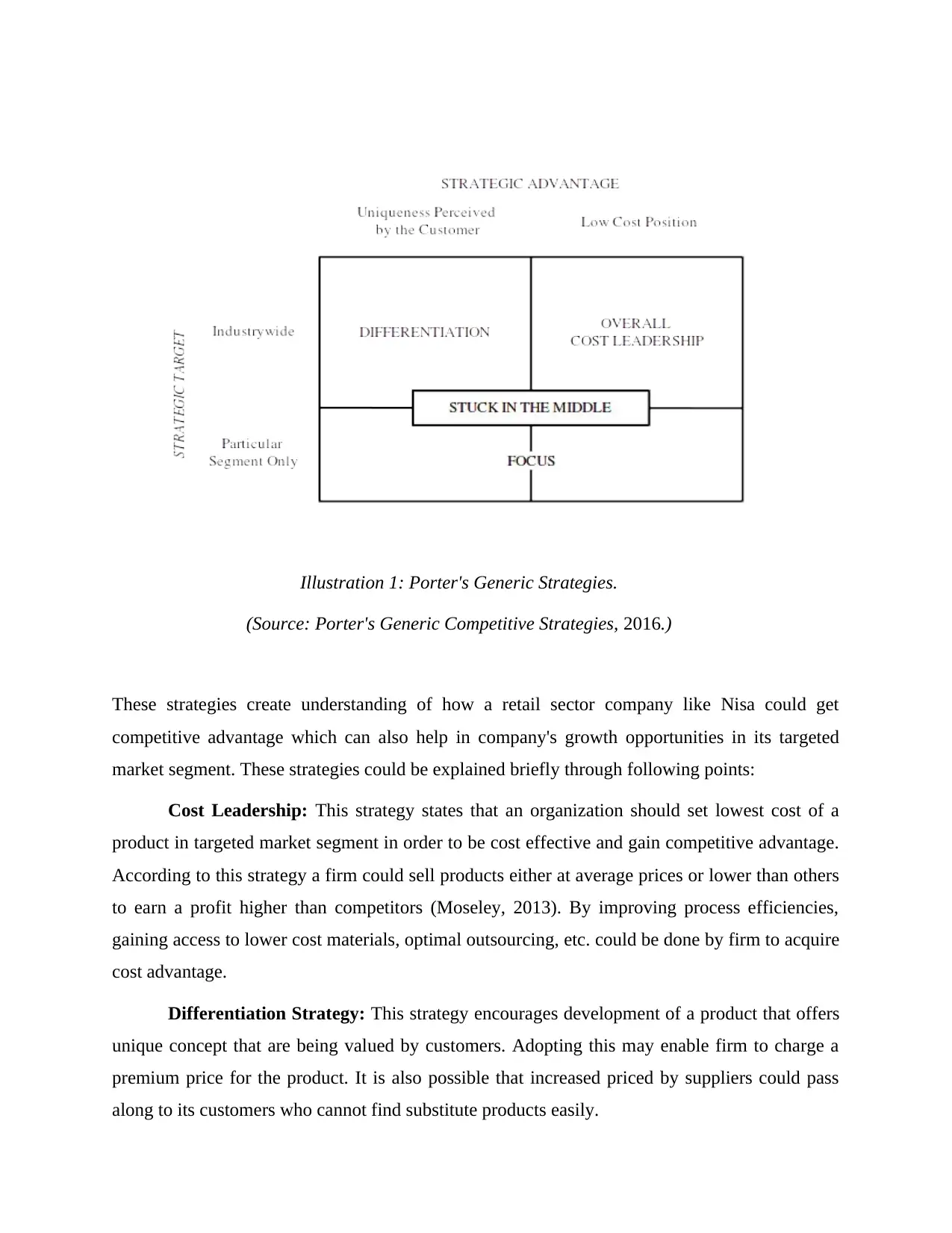
Illustration 1: Porter's Generic Strategies.
(Source: Porter's Generic Competitive Strategies, 2016.)
These strategies create understanding of how a retail sector company like Nisa could get
competitive advantage which can also help in company's growth opportunities in its targeted
market segment. These strategies could be explained briefly through following points:
Cost Leadership: This strategy states that an organization should set lowest cost of a
product in targeted market segment in order to be cost effective and gain competitive advantage.
According to this strategy a firm could sell products either at average prices or lower than others
to earn a profit higher than competitors (Moseley, 2013). By improving process efficiencies,
gaining access to lower cost materials, optimal outsourcing, etc. could be done by firm to acquire
cost advantage.
Differentiation Strategy: This strategy encourages development of a product that offers
unique concept that are being valued by customers. Adopting this may enable firm to charge a
premium price for the product. It is also possible that increased priced by suppliers could pass
along to its customers who cannot find substitute products easily.
(Source: Porter's Generic Competitive Strategies, 2016.)
These strategies create understanding of how a retail sector company like Nisa could get
competitive advantage which can also help in company's growth opportunities in its targeted
market segment. These strategies could be explained briefly through following points:
Cost Leadership: This strategy states that an organization should set lowest cost of a
product in targeted market segment in order to be cost effective and gain competitive advantage.
According to this strategy a firm could sell products either at average prices or lower than others
to earn a profit higher than competitors (Moseley, 2013). By improving process efficiencies,
gaining access to lower cost materials, optimal outsourcing, etc. could be done by firm to acquire
cost advantage.
Differentiation Strategy: This strategy encourages development of a product that offers
unique concept that are being valued by customers. Adopting this may enable firm to charge a
premium price for the product. It is also possible that increased priced by suppliers could pass
along to its customers who cannot find substitute products easily.
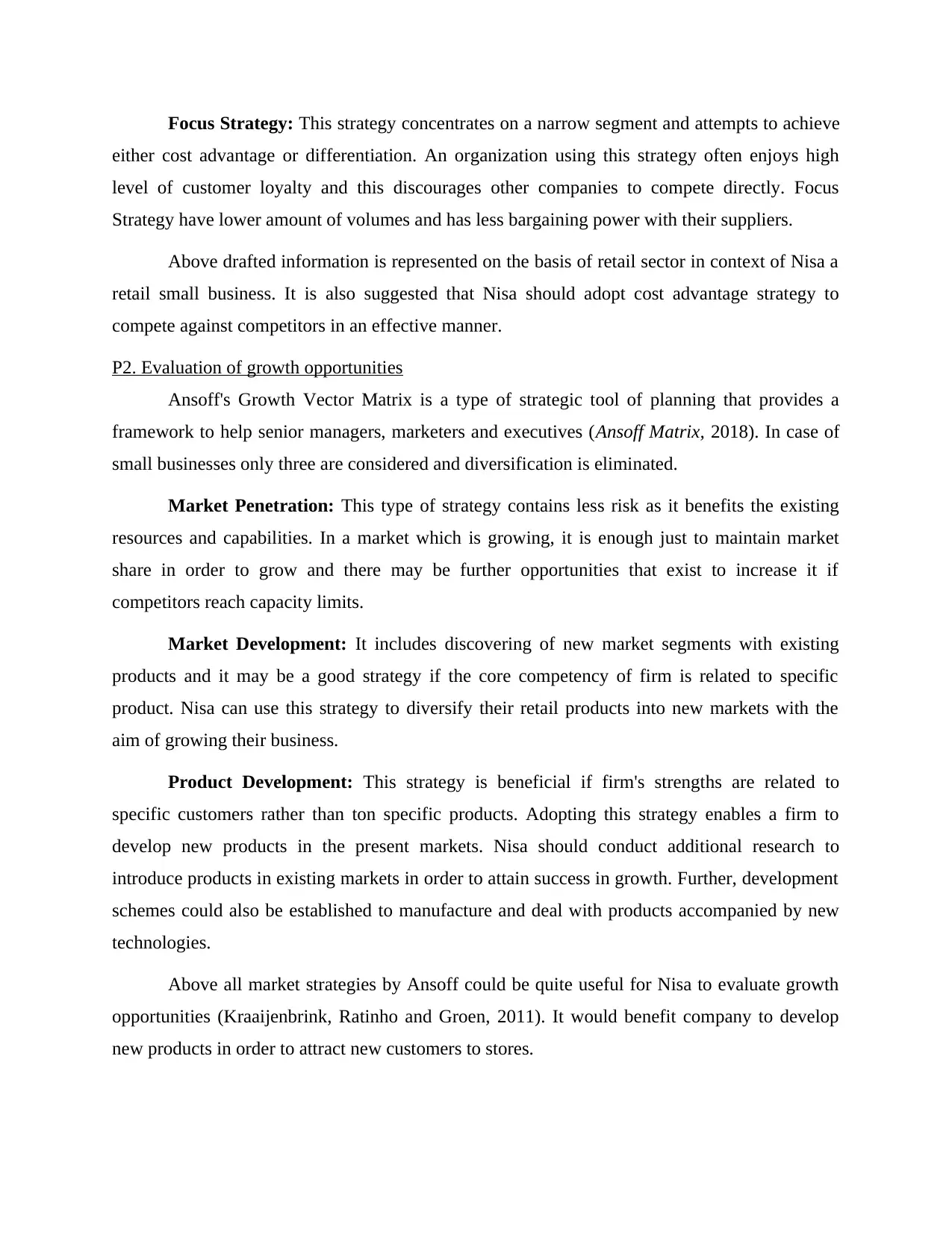
Focus Strategy: This strategy concentrates on a narrow segment and attempts to achieve
either cost advantage or differentiation. An organization using this strategy often enjoys high
level of customer loyalty and this discourages other companies to compete directly. Focus
Strategy have lower amount of volumes and has less bargaining power with their suppliers.
Above drafted information is represented on the basis of retail sector in context of Nisa a
retail small business. It is also suggested that Nisa should adopt cost advantage strategy to
compete against competitors in an effective manner.
P2. Evaluation of growth opportunities
Ansoff's Growth Vector Matrix is a type of strategic tool of planning that provides a
framework to help senior managers, marketers and executives (Ansoff Matrix, 2018). In case of
small businesses only three are considered and diversification is eliminated.
Market Penetration: This type of strategy contains less risk as it benefits the existing
resources and capabilities. In a market which is growing, it is enough just to maintain market
share in order to grow and there may be further opportunities that exist to increase it if
competitors reach capacity limits.
Market Development: It includes discovering of new market segments with existing
products and it may be a good strategy if the core competency of firm is related to specific
product. Nisa can use this strategy to diversify their retail products into new markets with the
aim of growing their business.
Product Development: This strategy is beneficial if firm's strengths are related to
specific customers rather than ton specific products. Adopting this strategy enables a firm to
develop new products in the present markets. Nisa should conduct additional research to
introduce products in existing markets in order to attain success in growth. Further, development
schemes could also be established to manufacture and deal with products accompanied by new
technologies.
Above all market strategies by Ansoff could be quite useful for Nisa to evaluate growth
opportunities (Kraaijenbrink, Ratinho and Groen, 2011). It would benefit company to develop
new products in order to attract new customers to stores.
either cost advantage or differentiation. An organization using this strategy often enjoys high
level of customer loyalty and this discourages other companies to compete directly. Focus
Strategy have lower amount of volumes and has less bargaining power with their suppliers.
Above drafted information is represented on the basis of retail sector in context of Nisa a
retail small business. It is also suggested that Nisa should adopt cost advantage strategy to
compete against competitors in an effective manner.
P2. Evaluation of growth opportunities
Ansoff's Growth Vector Matrix is a type of strategic tool of planning that provides a
framework to help senior managers, marketers and executives (Ansoff Matrix, 2018). In case of
small businesses only three are considered and diversification is eliminated.
Market Penetration: This type of strategy contains less risk as it benefits the existing
resources and capabilities. In a market which is growing, it is enough just to maintain market
share in order to grow and there may be further opportunities that exist to increase it if
competitors reach capacity limits.
Market Development: It includes discovering of new market segments with existing
products and it may be a good strategy if the core competency of firm is related to specific
product. Nisa can use this strategy to diversify their retail products into new markets with the
aim of growing their business.
Product Development: This strategy is beneficial if firm's strengths are related to
specific customers rather than ton specific products. Adopting this strategy enables a firm to
develop new products in the present markets. Nisa should conduct additional research to
introduce products in existing markets in order to attain success in growth. Further, development
schemes could also be established to manufacture and deal with products accompanied by new
technologies.
Above all market strategies by Ansoff could be quite useful for Nisa to evaluate growth
opportunities (Kraaijenbrink, Ratinho and Groen, 2011). It would benefit company to develop
new products in order to attract new customers to stores.
⊘ This is a preview!⊘
Do you want full access?
Subscribe today to unlock all pages.

Trusted by 1+ million students worldwide
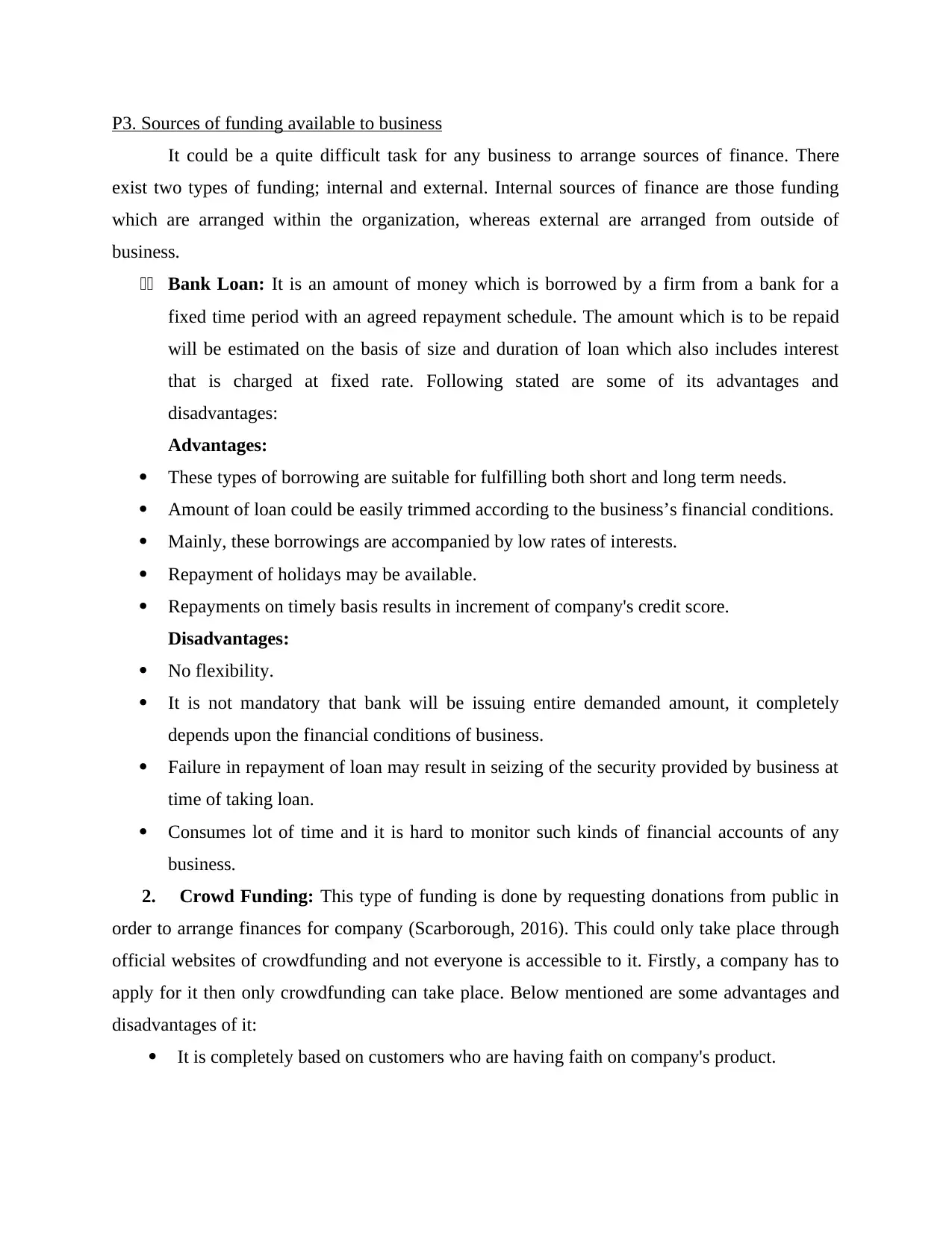
P3. Sources of funding available to business
It could be a quite difficult task for any business to arrange sources of finance. There
exist two types of funding; internal and external. Internal sources of finance are those funding
which are arranged within the organization, whereas external are arranged from outside of
business.
11 Bank Loan: It is an amount of money which is borrowed by a firm from a bank for a
fixed time period with an agreed repayment schedule. The amount which is to be repaid
will be estimated on the basis of size and duration of loan which also includes interest
that is charged at fixed rate. Following stated are some of its advantages and
disadvantages:
Advantages:
These types of borrowing are suitable for fulfilling both short and long term needs.
Amount of loan could be easily trimmed according to the business’s financial conditions.
Mainly, these borrowings are accompanied by low rates of interests.
Repayment of holidays may be available.
Repayments on timely basis results in increment of company's credit score.
Disadvantages:
No flexibility.
It is not mandatory that bank will be issuing entire demanded amount, it completely
depends upon the financial conditions of business.
Failure in repayment of loan may result in seizing of the security provided by business at
time of taking loan.
Consumes lot of time and it is hard to monitor such kinds of financial accounts of any
business.
2. Crowd Funding: This type of funding is done by requesting donations from public in
order to arrange finances for company (Scarborough, 2016). This could only take place through
official websites of crowdfunding and not everyone is accessible to it. Firstly, a company has to
apply for it then only crowdfunding can take place. Below mentioned are some advantages and
disadvantages of it:
It is completely based on customers who are having faith on company's product.
It could be a quite difficult task for any business to arrange sources of finance. There
exist two types of funding; internal and external. Internal sources of finance are those funding
which are arranged within the organization, whereas external are arranged from outside of
business.
11 Bank Loan: It is an amount of money which is borrowed by a firm from a bank for a
fixed time period with an agreed repayment schedule. The amount which is to be repaid
will be estimated on the basis of size and duration of loan which also includes interest
that is charged at fixed rate. Following stated are some of its advantages and
disadvantages:
Advantages:
These types of borrowing are suitable for fulfilling both short and long term needs.
Amount of loan could be easily trimmed according to the business’s financial conditions.
Mainly, these borrowings are accompanied by low rates of interests.
Repayment of holidays may be available.
Repayments on timely basis results in increment of company's credit score.
Disadvantages:
No flexibility.
It is not mandatory that bank will be issuing entire demanded amount, it completely
depends upon the financial conditions of business.
Failure in repayment of loan may result in seizing of the security provided by business at
time of taking loan.
Consumes lot of time and it is hard to monitor such kinds of financial accounts of any
business.
2. Crowd Funding: This type of funding is done by requesting donations from public in
order to arrange finances for company (Scarborough, 2016). This could only take place through
official websites of crowdfunding and not everyone is accessible to it. Firstly, a company has to
apply for it then only crowdfunding can take place. Below mentioned are some advantages and
disadvantages of it:
It is completely based on customers who are having faith on company's product.
Paraphrase This Document
Need a fresh take? Get an instant paraphrase of this document with our AI Paraphraser
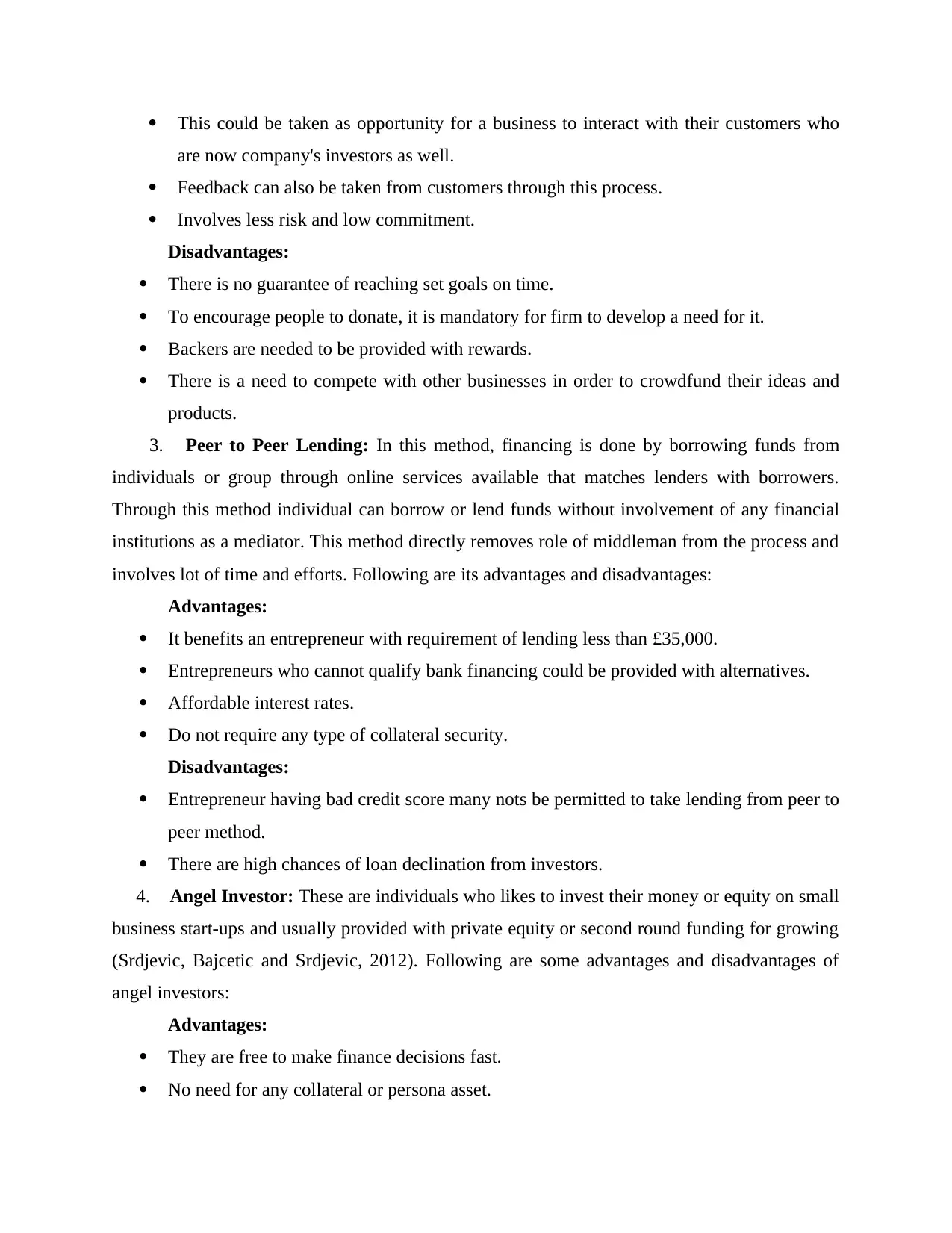
This could be taken as opportunity for a business to interact with their customers who
are now company's investors as well.
Feedback can also be taken from customers through this process.
Involves less risk and low commitment.
Disadvantages:
There is no guarantee of reaching set goals on time.
To encourage people to donate, it is mandatory for firm to develop a need for it.
Backers are needed to be provided with rewards.
There is a need to compete with other businesses in order to crowdfund their ideas and
products.
3. Peer to Peer Lending: In this method, financing is done by borrowing funds from
individuals or group through online services available that matches lenders with borrowers.
Through this method individual can borrow or lend funds without involvement of any financial
institutions as a mediator. This method directly removes role of middleman from the process and
involves lot of time and efforts. Following are its advantages and disadvantages:
Advantages:
It benefits an entrepreneur with requirement of lending less than £35,000.
Entrepreneurs who cannot qualify bank financing could be provided with alternatives.
Affordable interest rates.
Do not require any type of collateral security.
Disadvantages:
Entrepreneur having bad credit score many nots be permitted to take lending from peer to
peer method.
There are high chances of loan declination from investors.
4. Angel Investor: These are individuals who likes to invest their money or equity on small
business start-ups and usually provided with private equity or second round funding for growing
(Srdjevic, Bajcetic and Srdjevic, 2012). Following are some advantages and disadvantages of
angel investors:
Advantages:
They are free to make finance decisions fast.
No need for any collateral or persona asset.
are now company's investors as well.
Feedback can also be taken from customers through this process.
Involves less risk and low commitment.
Disadvantages:
There is no guarantee of reaching set goals on time.
To encourage people to donate, it is mandatory for firm to develop a need for it.
Backers are needed to be provided with rewards.
There is a need to compete with other businesses in order to crowdfund their ideas and
products.
3. Peer to Peer Lending: In this method, financing is done by borrowing funds from
individuals or group through online services available that matches lenders with borrowers.
Through this method individual can borrow or lend funds without involvement of any financial
institutions as a mediator. This method directly removes role of middleman from the process and
involves lot of time and efforts. Following are its advantages and disadvantages:
Advantages:
It benefits an entrepreneur with requirement of lending less than £35,000.
Entrepreneurs who cannot qualify bank financing could be provided with alternatives.
Affordable interest rates.
Do not require any type of collateral security.
Disadvantages:
Entrepreneur having bad credit score many nots be permitted to take lending from peer to
peer method.
There are high chances of loan declination from investors.
4. Angel Investor: These are individuals who likes to invest their money or equity on small
business start-ups and usually provided with private equity or second round funding for growing
(Srdjevic, Bajcetic and Srdjevic, 2012). Following are some advantages and disadvantages of
angel investors:
Advantages:
They are free to make finance decisions fast.
No need for any collateral or persona asset.
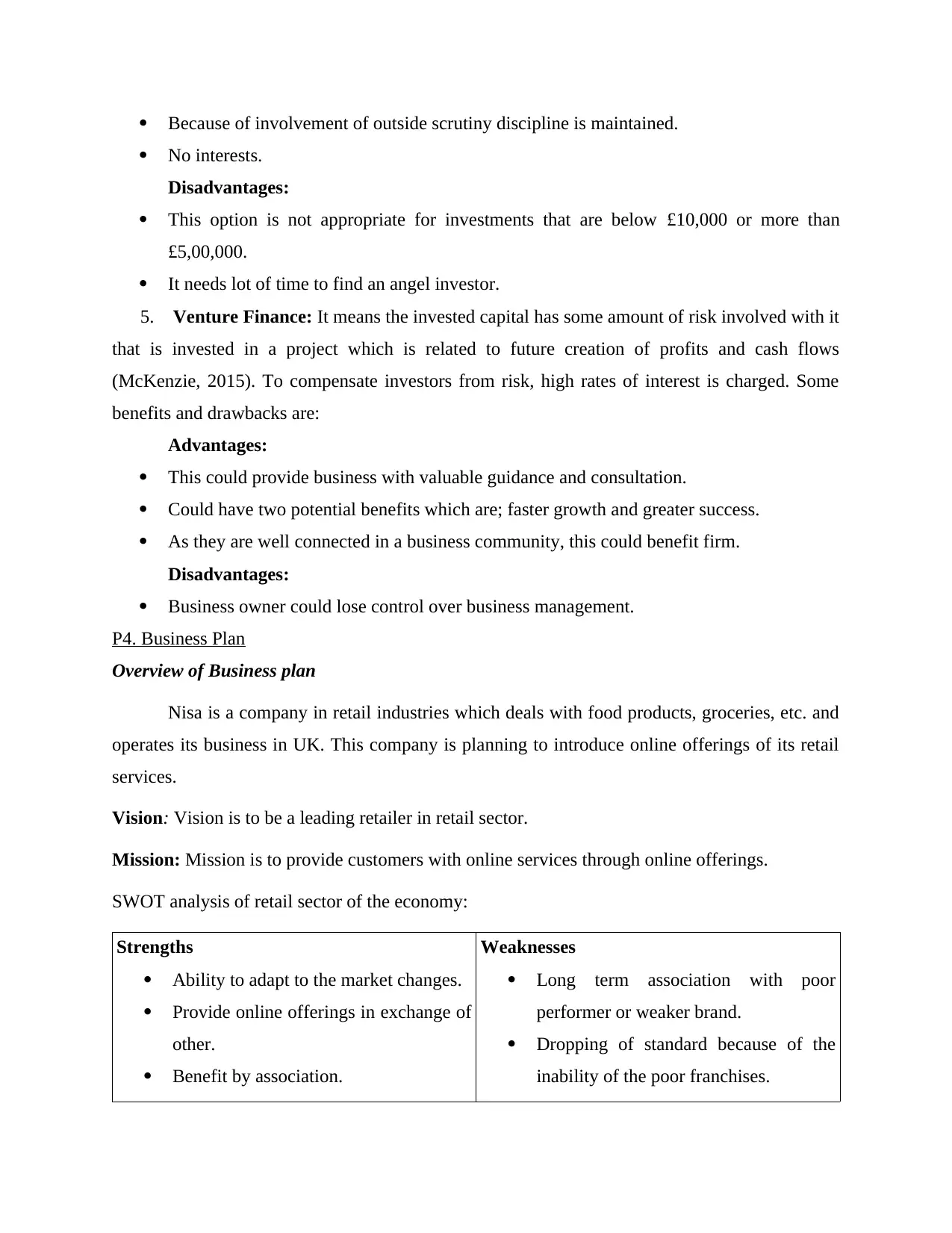
Because of involvement of outside scrutiny discipline is maintained.
No interests.
Disadvantages:
This option is not appropriate for investments that are below £10,000 or more than
£5,00,000.
It needs lot of time to find an angel investor.
5. Venture Finance: It means the invested capital has some amount of risk involved with it
that is invested in a project which is related to future creation of profits and cash flows
(McKenzie, 2015). To compensate investors from risk, high rates of interest is charged. Some
benefits and drawbacks are:
Advantages:
This could provide business with valuable guidance and consultation.
Could have two potential benefits which are; faster growth and greater success.
As they are well connected in a business community, this could benefit firm.
Disadvantages:
Business owner could lose control over business management.
P4. Business Plan
Overview of Business plan
Nisa is a company in retail industries which deals with food products, groceries, etc. and
operates its business in UK. This company is planning to introduce online offerings of its retail
services.
Vision: Vision is to be a leading retailer in retail sector.
Mission: Mission is to provide customers with online services through online offerings.
SWOT analysis of retail sector of the economy:
Strengths
Ability to adapt to the market changes.
Provide online offerings in exchange of
other.
Benefit by association.
Weaknesses
Long term association with poor
performer or weaker brand.
Dropping of standard because of the
inability of the poor franchises.
No interests.
Disadvantages:
This option is not appropriate for investments that are below £10,000 or more than
£5,00,000.
It needs lot of time to find an angel investor.
5. Venture Finance: It means the invested capital has some amount of risk involved with it
that is invested in a project which is related to future creation of profits and cash flows
(McKenzie, 2015). To compensate investors from risk, high rates of interest is charged. Some
benefits and drawbacks are:
Advantages:
This could provide business with valuable guidance and consultation.
Could have two potential benefits which are; faster growth and greater success.
As they are well connected in a business community, this could benefit firm.
Disadvantages:
Business owner could lose control over business management.
P4. Business Plan
Overview of Business plan
Nisa is a company in retail industries which deals with food products, groceries, etc. and
operates its business in UK. This company is planning to introduce online offerings of its retail
services.
Vision: Vision is to be a leading retailer in retail sector.
Mission: Mission is to provide customers with online services through online offerings.
SWOT analysis of retail sector of the economy:
Strengths
Ability to adapt to the market changes.
Provide online offerings in exchange of
other.
Benefit by association.
Weaknesses
Long term association with poor
performer or weaker brand.
Dropping of standard because of the
inability of the poor franchises.
⊘ This is a preview!⊘
Do you want full access?
Subscribe today to unlock all pages.

Trusted by 1+ million students worldwide
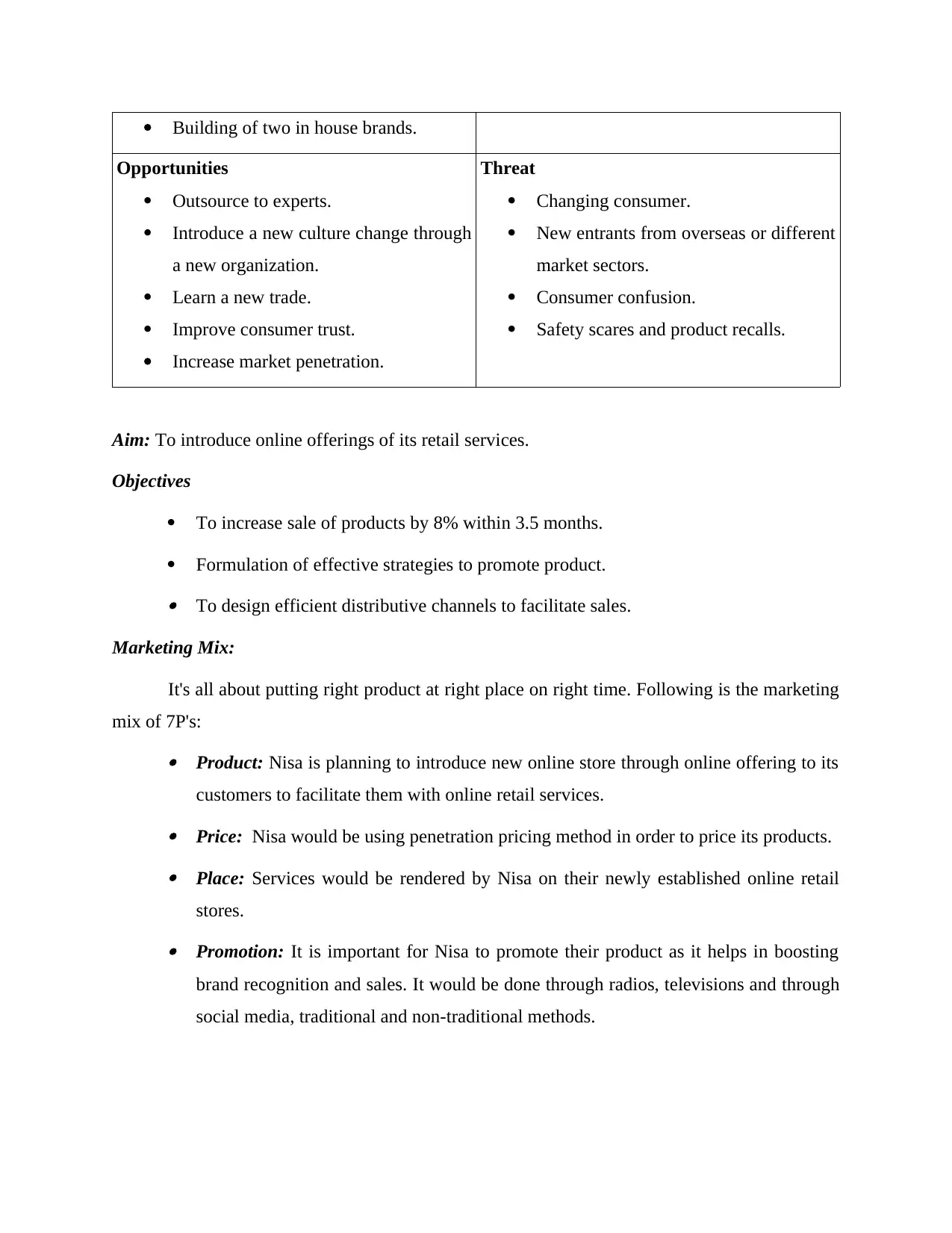
Building of two in house brands.
Opportunities
Outsource to experts.
Introduce a new culture change through
a new organization.
Learn a new trade.
Improve consumer trust.
Increase market penetration.
Threat
Changing consumer.
New entrants from overseas or different
market sectors.
Consumer confusion.
Safety scares and product recalls.
Aim: To introduce online offerings of its retail services.
Objectives
To increase sale of products by 8% within 3.5 months.
Formulation of effective strategies to promote product. To design efficient distributive channels to facilitate sales.
Marketing Mix:
It's all about putting right product at right place on right time. Following is the marketing
mix of 7P's: Product: Nisa is planning to introduce new online store through online offering to its
customers to facilitate them with online retail services. Price: Nisa would be using penetration pricing method in order to price its products. Place: Services would be rendered by Nisa on their newly established online retail
stores. Promotion: It is important for Nisa to promote their product as it helps in boosting
brand recognition and sales. It would be done through radios, televisions and through
social media, traditional and non-traditional methods.
Opportunities
Outsource to experts.
Introduce a new culture change through
a new organization.
Learn a new trade.
Improve consumer trust.
Increase market penetration.
Threat
Changing consumer.
New entrants from overseas or different
market sectors.
Consumer confusion.
Safety scares and product recalls.
Aim: To introduce online offerings of its retail services.
Objectives
To increase sale of products by 8% within 3.5 months.
Formulation of effective strategies to promote product. To design efficient distributive channels to facilitate sales.
Marketing Mix:
It's all about putting right product at right place on right time. Following is the marketing
mix of 7P's: Product: Nisa is planning to introduce new online store through online offering to its
customers to facilitate them with online retail services. Price: Nisa would be using penetration pricing method in order to price its products. Place: Services would be rendered by Nisa on their newly established online retail
stores. Promotion: It is important for Nisa to promote their product as it helps in boosting
brand recognition and sales. It would be done through radios, televisions and through
social media, traditional and non-traditional methods.
Paraphrase This Document
Need a fresh take? Get an instant paraphrase of this document with our AI Paraphraser
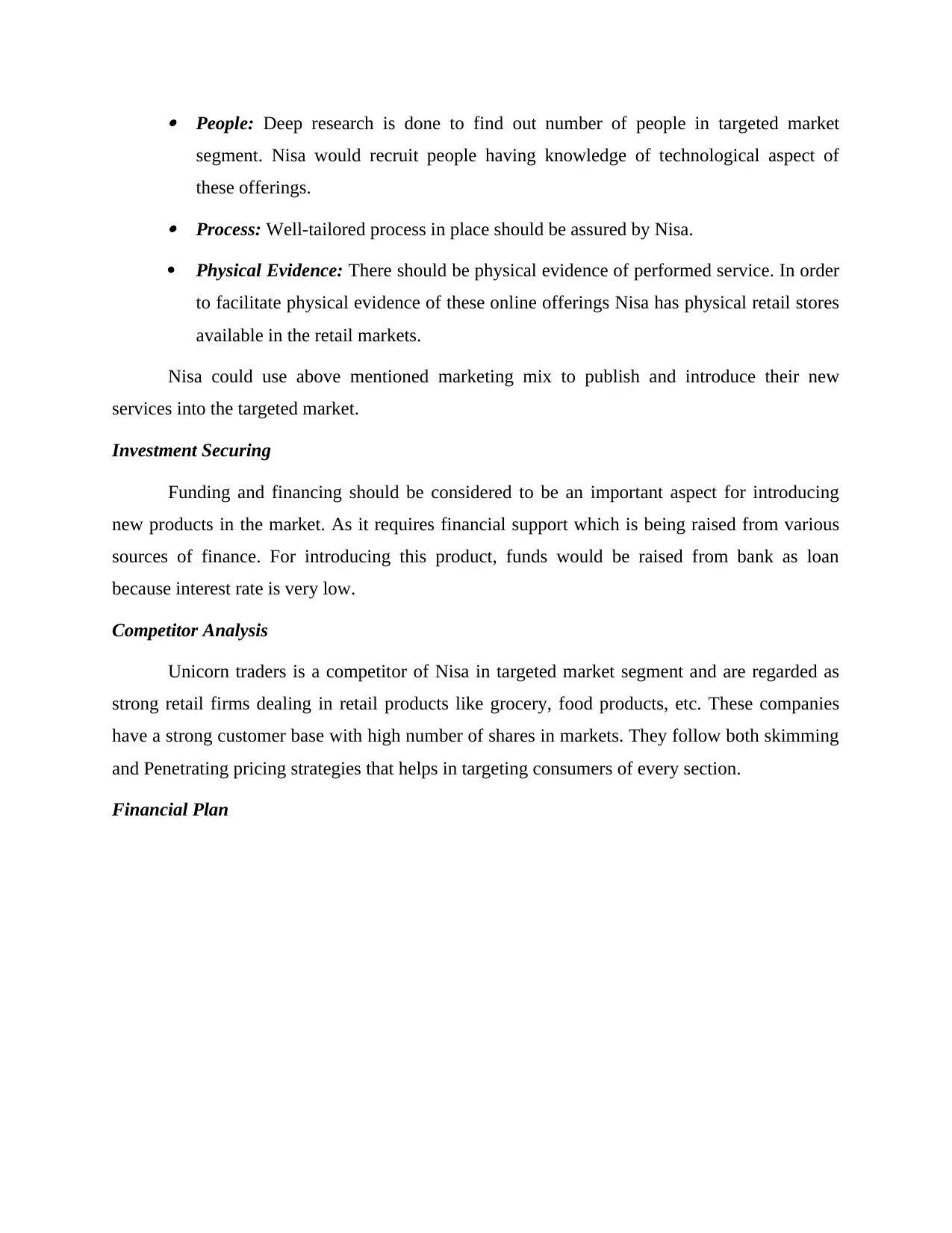
People: Deep research is done to find out number of people in targeted market
segment. Nisa would recruit people having knowledge of technological aspect of
these offerings. Process: Well-tailored process in place should be assured by Nisa.
Physical Evidence: There should be physical evidence of performed service. In order
to facilitate physical evidence of these online offerings Nisa has physical retail stores
available in the retail markets.
Nisa could use above mentioned marketing mix to publish and introduce their new
services into the targeted market.
Investment Securing
Funding and financing should be considered to be an important aspect for introducing
new products in the market. As it requires financial support which is being raised from various
sources of finance. For introducing this product, funds would be raised from bank as loan
because interest rate is very low.
Competitor Analysis
Unicorn traders is a competitor of Nisa in targeted market segment and are regarded as
strong retail firms dealing in retail products like grocery, food products, etc. These companies
have a strong customer base with high number of shares in markets. They follow both skimming
and Penetrating pricing strategies that helps in targeting consumers of every section.
Financial Plan
segment. Nisa would recruit people having knowledge of technological aspect of
these offerings. Process: Well-tailored process in place should be assured by Nisa.
Physical Evidence: There should be physical evidence of performed service. In order
to facilitate physical evidence of these online offerings Nisa has physical retail stores
available in the retail markets.
Nisa could use above mentioned marketing mix to publish and introduce their new
services into the targeted market.
Investment Securing
Funding and financing should be considered to be an important aspect for introducing
new products in the market. As it requires financial support which is being raised from various
sources of finance. For introducing this product, funds would be raised from bank as loan
because interest rate is very low.
Competitor Analysis
Unicorn traders is a competitor of Nisa in targeted market segment and are regarded as
strong retail firms dealing in retail products like grocery, food products, etc. These companies
have a strong customer base with high number of shares in markets. They follow both skimming
and Penetrating pricing strategies that helps in targeting consumers of every section.
Financial Plan
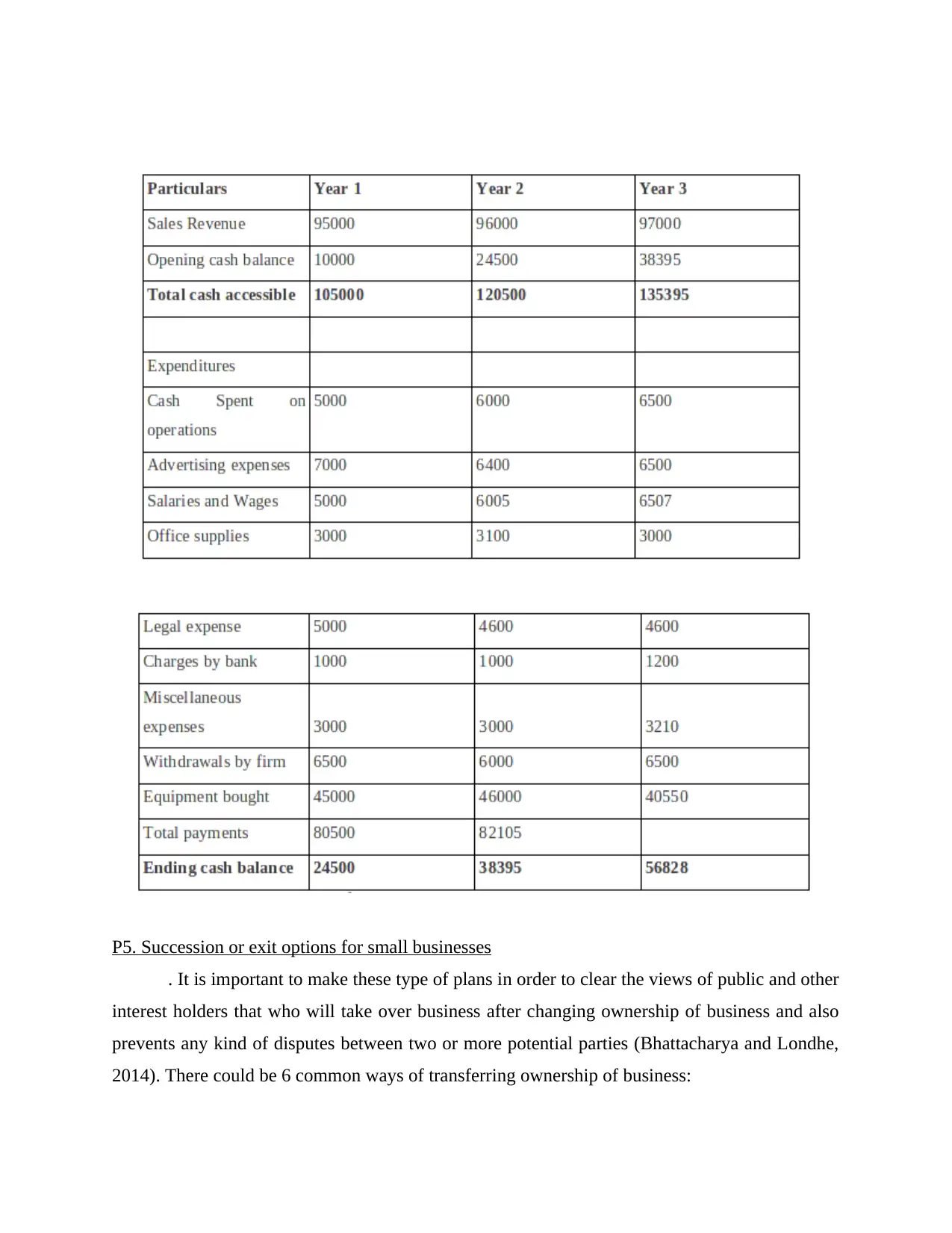
P5. Succession or exit options for small businesses
. It is important to make these type of plans in order to clear the views of public and other
interest holders that who will take over business after changing ownership of business and also
prevents any kind of disputes between two or more potential parties (Bhattacharya and Londhe,
2014). There could be 6 common ways of transferring ownership of business:
. It is important to make these type of plans in order to clear the views of public and other
interest holders that who will take over business after changing ownership of business and also
prevents any kind of disputes between two or more potential parties (Bhattacharya and Londhe,
2014). There could be 6 common ways of transferring ownership of business:
⊘ This is a preview!⊘
Do you want full access?
Subscribe today to unlock all pages.

Trusted by 1+ million students worldwide
1 out of 17
Related Documents
Your All-in-One AI-Powered Toolkit for Academic Success.
+13062052269
info@desklib.com
Available 24*7 on WhatsApp / Email
![[object Object]](/_next/static/media/star-bottom.7253800d.svg)
Unlock your academic potential
Copyright © 2020–2025 A2Z Services. All Rights Reserved. Developed and managed by ZUCOL.




